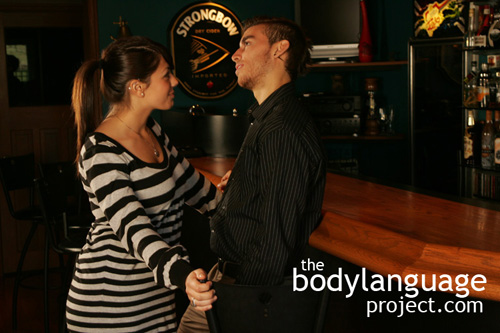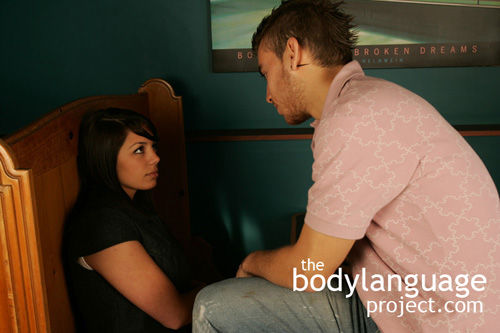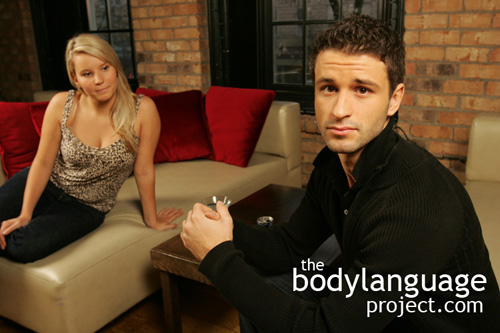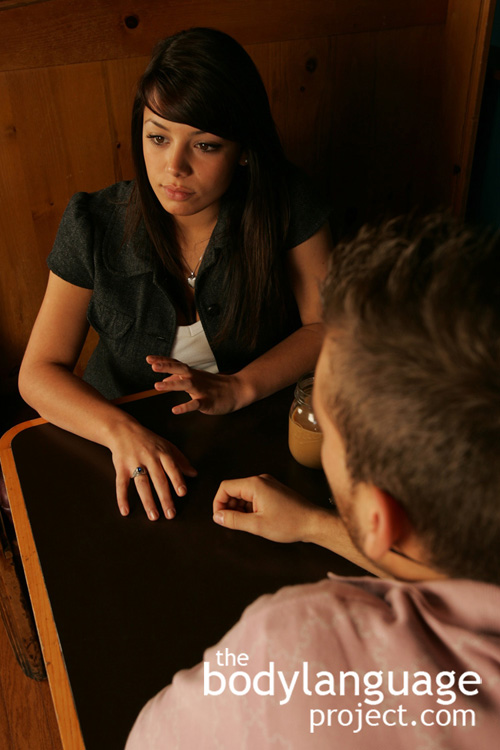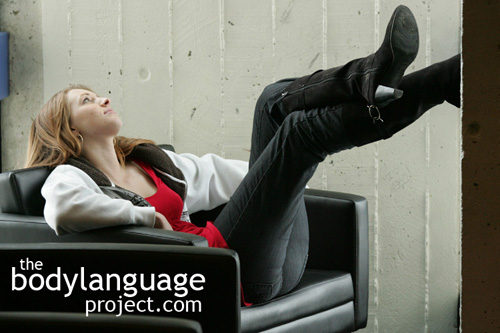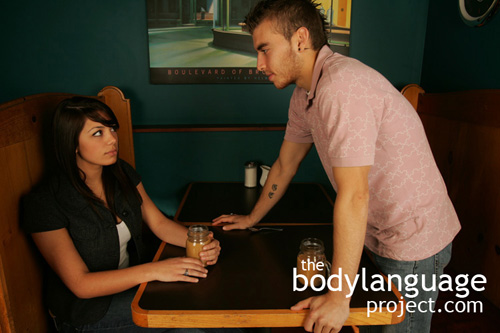Body language is a fundamental part of courtship. As we have learned, verbal language is risky and not only because it may lead to embarrassment, but because it often requires a verbal response from others, which can turn out to be tragically embarrassing. Keeping spoken words out of courtship initiation process and therefore out of consciousness will save us plenty of grief from being openly rejected, or perhaps even worse, negative feelings with having to reject. Using and reading nonverbal cues therefore is important in courtship, so pay particular attention to the following signals so you can judge interest yourself, without saying a word. Courtship signals are extensive and complex, perhaps numbering in the thousands, so I will only cover the basics here. For those that want more detail, they may wish to read my e-book Body Language Project: Dating, Attraction and Sexual Body Language (2007). Much more emphasis is placed on instruction for men to help them read women better, although it can be helpful to women who wish to send more appropriate signals of attraction, rejection or to simply bring from the subconscious the signals they use all the time.
Tag Archive for Signals
The Sequencing Of Rejection Body Language
by Chris Site Author • March 6, 2013 • 0 Comments
When people meet and rejection is present we see:
[A] The disinterested party turns their body and head away at a half turn.
[B] An expressionless face is assumed.
[C] The toes are re-oriented away from the speaker toward an exit, or other people. Distance separating the speaker and listener may increase by taking a step away.
[D] Fidgeting increases, swaying from side to side, picking finger nails and so forth.
[E] Poor eye contact is present and the listener frequently looks away or down.
[F] No, infrequent, poor, or random regulators are given such as “mhum” and head nods.
[G] No engagement in the conversation, no addition of unique input.
[H] Opportunity to leave is actively sought despite lack of necessity.
Clenching And Gripping
by Chris Site Author • March 6, 2013 • 0 Comments
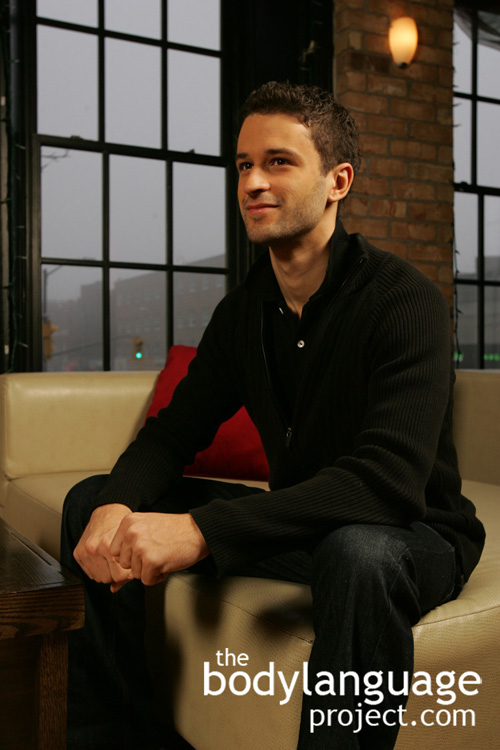
Fists into a ball is a classic expression of discomfort. The natural position for the hands is loose and relaxed, so when they ball-up, we know something is creating negative emotions. A smile, in this case, indicates stress, not happiness.
Clenching and gripping are signals of frustration and restraint. They are very different then the relaxed palm in palm gesture discussed in a previous chapter. A classic gripping posture happens when the hand opposite reaches behind the back and grabs the wrist of the opposite arm. We know it shows frustration because it serves to relieve tension through gripping, an energy displacement mechanism, and serves to show restraint because the hand is gripping the arm in effort to prevent them from striking out against another person.
Gripping, especially intensely, helps us feel more relaxed because the pain releases pleasure hormones and adrenaline. The same could be achieved through more constructive mechanisms like running, exercise, or constructing something useful, but like all forms of body language, the solutions come from an archaic part of the brain through evolution (or accident), so we are not interested in doing constructive work at a time when our minds are dealing with stress. In other words, we just want a quick, immediate fix for the anxiety, and wringing the hands helps sooth and pacifies us without having to leave the area. Most minds deal poorly with stress and can’t function normally without dealing with the source, so the last thing we want to do is leave the area in which the problem has arisen without a solution. Wringing the hands is a gesture that is seen in people the world over. At times the fingers may become interlaced appearing as if in prayer, which might even be the case. Pressure can be so great that the fingers can even blanch as blood flow is impeded.
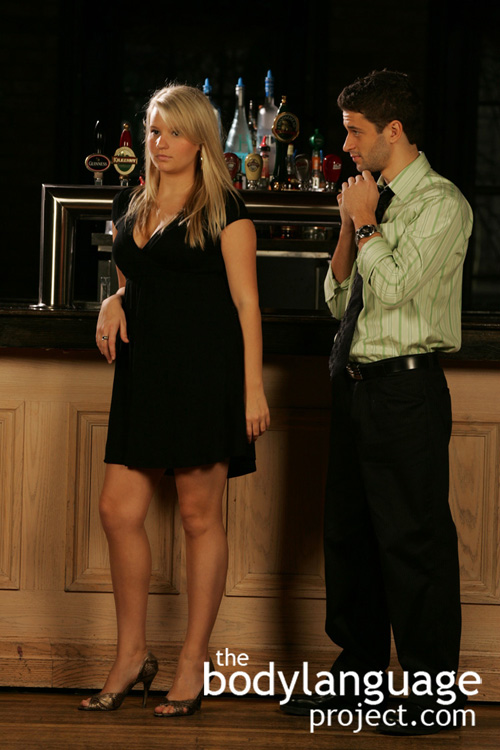
Extreme anxiety causes the desire to control the pain by inflicting it against ourselves. It gives back our sense of control over our anxiety. People who resort to ‘cutting’ also seek to displace their anxiety and control it.
Pacing is a classic full-blown signal of anxiety, and falls into the same energy displacement category because it gives us something to do and burns extra calories in a trickle to make us feel more relaxed. Clenching and gripping are ways of signaling that a negative thought or emotion is being held back. A more intense hand gripping posture happens when the arm grips higher up near the elbow or upper arm. The higher the grip, the more frustration is present and the more self control is expressing. Clenching and gripping postures occur anytime stress and anger is present, such as waiting to see a doctor or dentist, awaiting bad news, or during conflict.
Another form of clenching that shows emotional restraint happens with the hands in a raised position instead of being hidden behind the back. This form of clenching appears as if the hands are being rung out by each other, as we would a wet article of clothing. Smiling does not negate the gesture either, and even alludes to a greater than normal tension. Smiles when accompanied by wringing, are called “stress smiles” or grimacing. The hands can be held in front of the face, resting on the desk or lap or when standing, in front of the crotch, but once again, the higher the clenching appears the more prevalent and obvious is the tension.
The hands and feet are key places to verify anxiety and will be the usual suspects in betraying emotions. They move easily and freely from the rest of the body and can be used to burn energy and release stress anxiety without requiring the body to move large distances. Because they can be moved independent of the body, they also tend to leak information more readily. Therefore, to read anxiety carefully watch for tapping toes or fingers, or feet that move frequently or never seem to find a comfortable position as well as any other repetitive behaviours. Foot movements will show more restraint than hand movements especially if someone is trying to hide their fears from others.
Clenching and gripping can have many other forms as well, including clenching the jaws tight or even talking through the teeth, cracking knuckles, pulling the hair or even plucking it, pinching one’s self, and clenching the fists by turning them into a ball. In my observations of other people, I have noticed some peculiar emotional behaviour that includes the grotesque such as squeezing pimples to plucking nose hairs to more damaging and extreme behaviours such as hitting the head and scratching called “self harm” but can include any other painful and repetitive behaviours serving to sooth emotional stress.
The more astute will notice tension from something so minor that most won’t even notice, and the carrier of which, will have no conscious awareness. That is, sitting in an awkward position, or rather, sitting in a less than fully relaxed position. This cue tells us that they won’t and can’t permit themselves to take on a more relaxed position because they should be doing something else more pressing or useful. Perhaps watching television isn’t of highest priority when one weighs the importance of a report or an essay for school, that the house needs tending to, or family time has been ignored. Notice a fully relaxed position for a person over time, and then note when they aren’t holding it, then you’ll know something isn’t right in their minds! Identify the pattern, call them out on it, and then look like a genious!
Relaxed Body Language
by Chris Site Author • March 5, 2013 • 0 Comments
Identifying relaxed body language helps us find people that belong, or that feel they belong, in a given situation. Those that are relaxed do so in environments they “own” and control and the higher is a persons’ status, the more diverse will be these environments, although situational novelty also plays a major role in comfort. Even low status people have a variety of locations in which they feel relaxed because being relaxed is a function of feeling that no threat is present and this is based largely on experience. Someone ridding a subway for the first time, for example, will be tensed and show rigid body postures like a coiled spring. They will be looking around at the subway signs and various indicators, and the people around them. It is impossible to be and look relaxed when the senses are on alert, when we’re keen to watch for signals of danger suspecting that all noises around us could indicate imminent danger. Someone that rides the subway daily won’t notice the signs and sounds around them, just like a highway driver zones out for the majority of the drive only to find out somehow he has arrived at his destination. Subway riders might even be so relaxed that they doze off on their route or become engrossed in a newspaper or magazine and miss their stop.
Relaxed body language is any body language that lacks muscle tension, the body is loose and the arms and legs move freely and naturally swaying with any motion. The torso may sag slightly to one side, or slump, but is not held by irregular tension. Thus, the body holds regular open body postures, with the arms and legs uncrossed. A leg might even be tucked under the body, to be sat on, showing that one is not prepared to leave and doesn’t expect to be caught off-guard. Breathing is steady and slow and can even become deep showing even more relaxation. Smiles happen in coordination with the eyes and the lips are not simply stretching across the face. The eyebrows are stable or move along with speech rather than frowning and the eyes gaze rather than stare and blink at a regular rate. The forehead will have no tension and we should watch for wrinkles which is an easy give-away to tension. Lines and wrinkles in the forehead quickly showing fear. Lastly, the skin colour is normal, not red showing embarrassment or anger, and isn’t pale with fear.
Eyebrow Flash – The Social Greeting
by Chris Site Author • March 5, 2013 • 0 Comments
They eyebrow flash has been studied for decades most notably by German behavioural research scientist Eibl-Eibesfeldt. He found that the eyebrow flash is a universally recognized long distance social greeting. The only exception is in Japan where it is considered an overt sexual invitation and therefore inappropriate. For everyone else the eyebrow flash in a sort of nonverbal “Hello” or “Hey there, I know you”. The eyebrow flash happens very briefly and lasts only about one-sixth of a second. It is a quick raising and lowering of the eyebrows. The flash normally happens over a distance of between six to twelve feet by which dialogue can not easily occur, but of which, signals to another party that you have recognized them. The video of Fergie and Prince Andrew’s wedding provides a real life example of the eyebrow flash as she makes her way down the aisle.
The eyebrow flash could be a response to surprise, as if saying “Hey, I noticed you and am surprised, but also fearful because I’ve been taken off guard.” Therefore, the eyebrow flash sends the message that you aren’t a threat, since you’ve been taken by surprise. Another theory advanced says that the eyebrow flash draws attention to the face so that less ambiguous signals can be exchanged.
Research shows us that eyebrow flashes are infrequently used between individuals who are enduring strained relationships, so this can be used as a test. If you aren’t sure, try an eyebrow flashing on a colleague you’ve recently had a fight with. If the signal elicits a flash back then you have been forgiven, but if the flash is denied or you instead receive a dirty look then your transgressions are still at the forefront of their mind.
Eye contact between those in strained relationships is rigorously avoided under most circumstances, most likely so there is a reduced probability that the greeting extends to further unwanted interaction. We can therefore look at the eyebrow flash as a nonverbal conversation starter and lack thereof as a conversation avoider.
Eye Flashes, Eye Widening And Flashbulb Eyes
by Chris Site Author • March 5, 2013 • 0 Comments
The eye flash is similar to the eyebrow flash in that they both occur very quickly. In the case of the eye flash it lasts on average for only 0.75 seconds but is easily perceived and is quite obvious. The eye flash is a momentary widening of the eyelids during a conversation to reveal the sclera, or whites of the eyes, with no involvement of the eyelids. Humans are the only primates that have whites around their eyes whereas other ape’s eyes are completely dark. It has been theorized that the whites of the eyes evolved as a means of communication helping indicate eye direction.
The eyeflash when given by a speaker, emphasizes specific words being spoken. The eyeflash can serve to change the meaning of a given word or phrase by putting emphasis on one word over another. It normally accompanies adjectives rather than any other parts of speech, and women use it more often them men. I did however notice Brad Pitt perform the eyeflash repeatedly while in a speaking scene in a movie. I’m not sure exactly sure what his intent of the flash entailed, as it accompanied no talking and it occurred once every few seconds while listening, and to me, it seemed odd. Never-the- less he must have thought it added emphasized to his part in the scene. Of note is when eyebrows start and stop flashing as they indicate attachment and excitement with whatever content is being presented. If eyes suddenly stop flashing then it’s likely that a person is lacking in enthusiasms and commitment for the topic at hand. The eyeflash is also association with raised eyebrows to signal submission. Lowering the eyebrows of course, signals the opposite, that is dominance.
On the other hand, a loving mother will widen her eyes when viewing her newborn baby indicating that she cares for them and within seventy-two hours of birth her child will do the same when she enters the room. Eye widening is a positive nonverbal cue indicating that someone is observing positive stimuli that bring them joy and happiness. Eye widening is another form of gravity defying behaviour that is ubiquitous in showing positive emotions and joy. When true contentment is present the eyes will lack any tension at all and will appear relaxed. The size of the eyes directly indicates how positive someone is about a topic. While making eyes bigger and flashing them means that good thoughts are held, squinting where the eyes are compressed means negative thought are held. The same goes for lowered eyebrows!
The final eye cue is flashbulb eyes, which is done by dramatically opening the eyes as big and wide as possible. The eyebrows usually arch in unison as well to make the eyes appear even larger. The cue is usually done to indicate surprise and positive emotions such as being excited to see someone, or have been given a promotion.
[help! – Brad Pitt’s filmology shows over sixty movies and I can’t figure out which movie he was in when he did the eye flash. I do recall it was an older movie and don’t think he was actively speaking at the time, more listening, and in an alley/dark area of some sort. If you know the movie send it my way!]
Indicators of Invasion
by Chris Site Author • March 5, 2013 • 0 Comments
There are some very simple ways in which people indicate that they are being invaded, and they are important should one want to avoid offending them. As we have learned in this chapter, personal space is important to all people and so we want to be cautious not to intrude on others for two reasons: first, for the sake of the comfort of the people around us, and second, for our own sake, so that people don’t attach negative ideas to us.
Strangers should be given the most amount of space until we get to know them so we should avoid breaking the five foot separation mark unless invited to do so. While it might seem rude to keep a new acquaintance at a distance and five feet might even seem like a huge distance, it’s a clearly defined ritual and a benchmark that most people find commonplace. For those that use touch to display connectivity (the touchy-feely ones) should show reservation at least until proper rapport is built and your acquaintance shows relaxed and open signals. Handshakes are common across most culture and are acceptable greeting method when meeting new people. The kiss-hello and other more intimate methods to greet find their place in many cultures, but the handshake is becoming more and more popular across the globe, so it’s a fairly safe bet it will be well received. After the handshake is complete, on should take a step back or to the side to converse. Next, you should allow the other person to define their preferred zone in which to carry on the remainder of the interaction. This is done by allowing them to move forward or backward if they desire. Eventually you will find a happy medium between you and them, so do avoid continuously approaching or leaning forward, in other words, plant your feet and keep an upright body.
Your partner will signal that you are encroaching on them and making them feel uncomfortable by taking a step backwards. If this isn’t possible due to space restrictions, or while in tight quarters such as an elevator, or if continuously followed by advancements, your partner will begin to pull their heads backwards and away. Even when space is not limited, we may find that polite people that don’t wish to overtly show that they are being infringed upon may also simply pull their heads back versus stepping backwards. If you find that you are constantly moving forward, then it’s likely because your comfort distance is less than the comfort distance of others.
Others might just show a bigger smile (possibly showing stress) and simply pretend that nothing is bothering them, but as soon as eye contact is broken or when their speaking partner is distracted, will take a step back. Others still, can pull their arms up and out to reserve space or can use their hand on the sleeve of the other to keep them from advancing. Arm crossing also demonstrates a negative posture and is used to shield the body so this can also indicate encroachment. Respecting other people’s intimate zones is extremely important. Invading people’s space can cause anxiety, irritation, anger or fear. If all else fails, you know you’ve exceeded the general personal space of others when your eyes begin to fuzz or cross, or you feel the uncomfortable sensation of warm breath on your face. When all else fails, take a step back and let them close the gap.
Spatial Empathy
by Chris Site Author • March 5, 2013 • 0 Comments
“Spatial empathy” is an informal term used by expatriate workers in Hong Kong and then later in Japan and China who were typically from Australia, England, France and the United States. The term was use to describe the awareness that individuals have about how their proximity affects the comfort of the people around them. Even though cities such as Hong Kong, Japan and China were westernized, the walkways and public transport system were very crowded by comparison. The expatriates found that preventing intrusion into their personal space was difficult and at times impossible.
The foreign workers that were not accustomed to physical closeness and physical contact were made to feel violated by the locals. They felt that their privacy was being infringed upon and that their personal space requirements weren’t being met. What the workers failed to realize was that it was their responsibility to adapt to the cultural norms of the locals and not the other way around so while the locals had no spatial empathy the workers had no cultural empathy.
While spatial empathy was first coined to describe the differences between cultures it also has application within cultures as some people have different levels of tolerance with regards to their personal space. Naturally, it is your choice to decide what you will do with someone else’s preference, be it to respect it by reading their signals and give them space, or ignore it and invade it. I supposed it would have everything to do with what your goals happens to be. Will you respect the needs of the people around you and try to make them feel comfortable or will you invade their space to fulfill your own needs?
How To Use Regulators
by Chris Site Author • March 5, 2013 • 0 Comments
Regulators, regulate speech and control turn taking. Literally we can increase or decrease the amount of talking that happens with simple body language. For example, to increase speaking add more nodding. When people stop and you wish for them to continue simply nod your head, and, more often than not, this will encourage them to begin speaking again. The use of “mhums” and “yeses” will have the same effect. To speed speech up, or end a conversation altogether, send frequent looks away or down to your watch.
Too much nodding, on the other hand, shows indifference which can be a useful tactic depending on the speaker and your intent. Three nods in quick succession shows that you are ready to speak yourself and has the net effect of increasing their rate of speech to avoid being cut off. Drawing in air and parting the lips while tilting the head back slightly also gives the impression that someone is prepared to speak, as does patting the mouth with two fingers. Looking at your watch or looking to the doorway will make people talk less or if done excessively stop altogether.
Try this experiment. As your conversation begins nod your head every few seconds or as you see agreement. Next, increase the rate at which you nod your heard regardless of any agreement. What happens when you increase your nod frequencies? Most likely, up to about two to three continuous nods, they will become more excited believing they are building rapport. What if you nod continuously? I suspect it will stop the conversation altogether. Recall that three quick nods means that you wish to interject, while continuous nodding comes across as feigned agreement sending the conversation into a standstill. What happens with appropriate nodding absent of proper eye contact? This signals to others that their conversation is falling on deaf ears, and will be taken as an insult. The same goes with random nodding that has lost synchrony with speech. Telephone conversations easily fall off their rails if one party becomes preoccupied with another task. We immediately sense that their regulators have become unlinked from the conversation and when it comes time for them to speak, we hear nothing in return, or there is a delay. Not surprisingly, we find that the person on the other end is watching television – an obvious insult.
When people near the end of their though, and wish for their partner to speak, they will often lower their volume and slow their voice down slightly. Other times, the final syllable will be drawn out or gesturing with the hands will become less frequent or stop altogether. The eyes too are often lowered along with the head but at the very last moment eye contact will resume indicating that it’s time for the other person to begin speaking.
Raising the index finger can also signal a desire to speak which we learn early on in grade school which is normally accompanied by a sharp and deep intake of air. To stifle the “index finger interjector”, extend your hand across and make light contact with their forearm. This is a polite nonverbal way to show that you acknowledge their desire to speak, but that you haven’t quite concluded your point. If you sincerely wish to communicate interest and increase speaking, add a slight head tilt and a half frown or half-smile. This shows the speaker that what they have said is unclear but that you otherwise find it fascinating and wish to learn more.
Good communicators will make great partners amongst all types of speakers, even those that seem to carry on endlessly or those with little to say. They will have a strong arsenal of tools to cut one set of speaker off nonverbally, or as the case may be, encourage them to speak further. While we may take regulators for granted, conversations would be awkward and disjointed without them. Experiment a little for yourself and see how you can modify behaviour with regulators to suite your needs.


